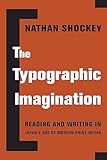The Typographic Imagination : Reading and Writing in Japan’s Age of Modern Print Media / Nathan Shockey.
Material type: TextSeries: Studies of the Weatherhead East Asian Institute, Columbia UniversityPublisher: New York, NY : Columbia University Press, [2019]Copyright date: ©2019Description: 1 online resourceContent type:
TextSeries: Studies of the Weatherhead East Asian Institute, Columbia UniversityPublisher: New York, NY : Columbia University Press, [2019]Copyright date: ©2019Description: 1 online resourceContent type: - 9780231194280
- 9780231550741
- Book industries and trade -- Japan -- History -- 19th century
- Book industries and trade -- Japan -- History -- 20th century
- Books and reading -- Japan -- History -- 19th century
- Books and reading -- Japan -- History -- 20th century
- Printing -- Japan -- History -- 19th century
- Printing -- Japan -- History -- 20th century
- LITERARY CRITICISM / Asian / Japanese
- 381/.45002095209034 23
- Z463.3 .S437 2020
- online - DeGruyter
| Item type | Current library | Call number | URL | Status | Notes | Barcode | |
|---|---|---|---|---|---|---|---|
 eBook
eBook
|
Biblioteca "Angelicum" Pont. Univ. S.Tommaso d'Aquino Nuvola online | online - DeGruyter (Browse shelf(Opens below)) | Online access | Not for loan (Accesso limitato) | Accesso per gli utenti autorizzati / Access for authorized users | (dgr)9780231550741 |
Browsing Biblioteca "Angelicum" Pont. Univ. S.Tommaso d'Aquino shelves, Shelving location: Nuvola online Close shelf browser (Hides shelf browser)

|

|

|

|

|

|

|
||
| online - DeGruyter Spaces Mapped and Monstrous : Digital 3D Cinema and Visual Culture / | online - DeGruyter Extraordinary Justice : Law, Politics, and the Khmer Rouge Tribunals / | online - DeGruyter Experiencing Design : The Innovator's Journey / | online - DeGruyter The Typographic Imagination : Reading and Writing in Japan’s Age of Modern Print Media / | online - DeGruyter The Huayan University Network : The Teaching and Practice of Avataṃsaka Buddhism in Twentieth-Century China / | online - DeGruyter Archives of Conjure : Stories of the Dead in Afrolatinx Cultures / | online - DeGruyter Arts of Address : Being Alive to Language and the World / |
Frontmatter -- CONTENTS -- ACKNOWLEDGMENTS -- A NOTE ON ROMANIZATION AND TRANSLATION -- Introduction: The World Made Type -- PART I. The Making of a Modern Media Ecology -- Chapter One. Pictures and Voices from a Paper Empire -- Chapter Two. Iwanami Shoten and the Enterprise of Eternity -- Chapter Three. The Topography of Typography: Bibliophiles and Used Books in the Print City -- PART II. Prose, Language, and Politics in the Type Era -- Chapter Four. New Age Sensations: Yokomitsu Riichi and the Contours of Literary Discourse -- Chapter Five. Brave New Words: Orthographic Reform, Romanization, and Esperantism -- Chapter Six. The Medium Is the Masses: Print Capitalism and the Prewar Leftist Movement -- Conclusion: Ends, Echoes, and Inversions -- NOTES -- SELECTED BIBLIOGRAPHY -- INDEX
restricted access online access with authorization star
http://purl.org/coar/access_right/c_16ec
In the early twentieth century, Japan was awash with typographic text and mass-produced print. Over the short span of a few decades, affordable books and magazines became a part of everyday life, and a new generation of writers and thinkers considered how their world could be reconstructed through the circulation of printed language as a mass-market commodity. The Typographic Imagination explores how this commercial print revolution transformed Japan’s media ecology and traces the possibilities and pitfalls of type as a force for radical social change.Nathan Shockey examines the emergence of new forms of reading, writing, and thinking in Japan from the last years of the nineteenth century through the first decades of the twentieth. Charting the relationships among prose, politics, and print capitalism, he considers the meanings and functions of print as a staple commodity and as a ubiquitous and material medium for discourse and thought. Drawing on extensive archival research, The Typographic Imagination brings into conversation a wide array of materials, including bookseller trade circulars, language reform debates, works of experimental fiction, photo gazetteers, socialist periodicals, Esperanto primers, declassified censorship documents, and printing press strike bulletins. Combining the rigorous close analysis of Japanese literary studies with transdisciplinary methodologies from media studies, book history, and intellectual history, The Typographic Imagination presents a multivalent vision of the rise of mass print media and the transformations of modern Japanese literature, language, and culture.
Mode of access: Internet via World Wide Web.
In English.
Description based on online resource; title from PDF title page (publisher's Web site, viewed 25. Jun 2024)


